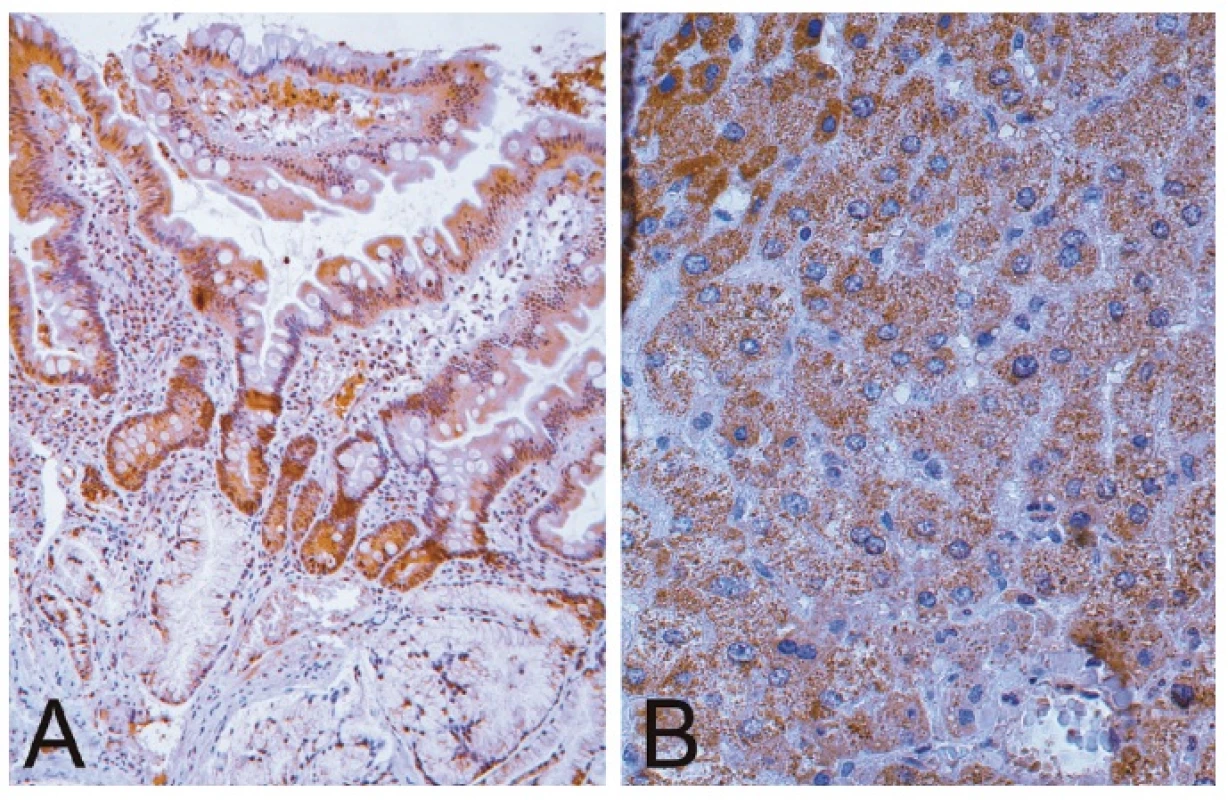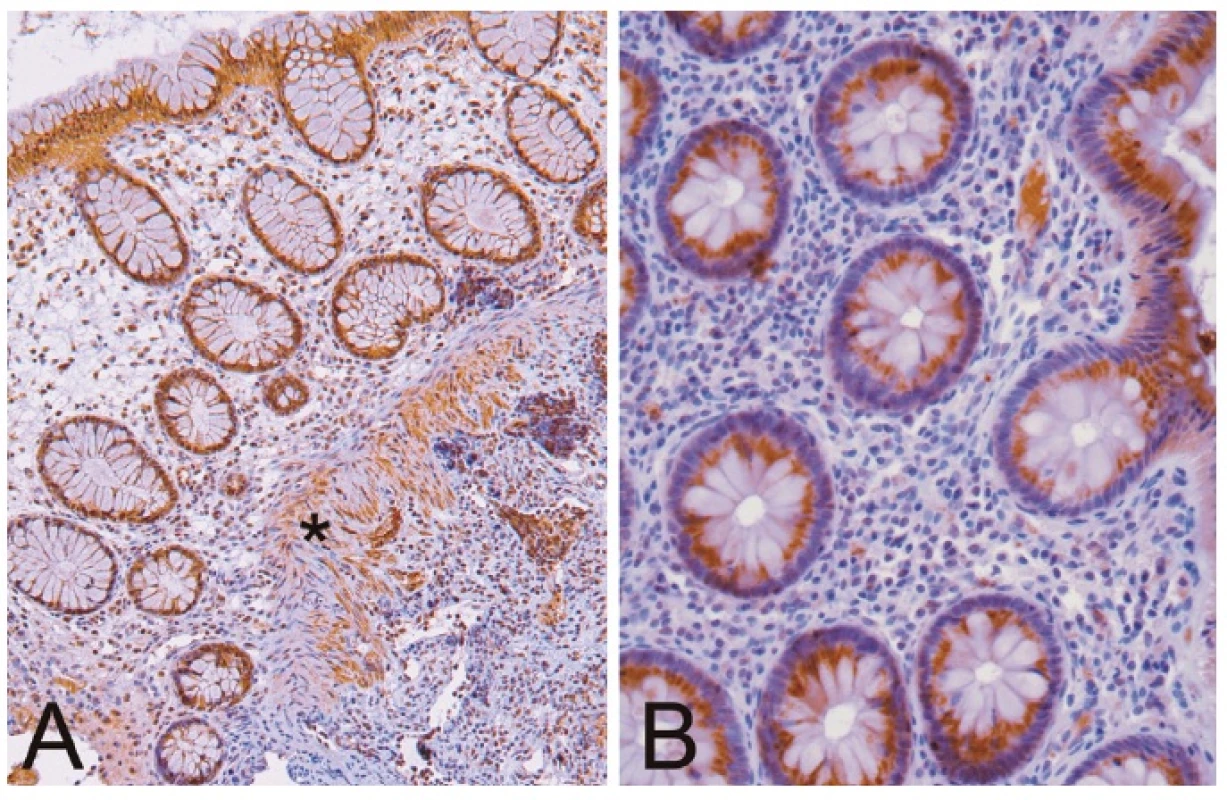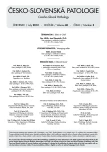Immunoexpression of type-1 adiponectin receptor in the human intestine
Imunoexprese adiponektinového receptoru typu 1 v lidském střevě
Adiponektin je důležitý biomarker metabolického syndromu, který byl v nedávné době identifikován také v mateřském mléce člověka. V naší práci prokazujeme přítomnost adiponektinového receptoru typu 1 (adipoR1) imunoperoxidázovou metodou ve 21 bioptických vzorcích – duodenum (n = 6), terminální ileum (n = 7) a kolon (n = 8) od 14 jedinců (6 žen a 8 mužů ve věku 9 měsíců – 47 let). Ve všech vzorcích jsme prokázali přítomnost adipoR1. Pozitivita byla pozorována v enterocytech, kolonocytech i v lymfocytech submukózy a v hladké svalovině střevní stěny. Předpokládáme, že adiponektin může ovlivňovat intestinální fyziologické děje prostřednictvím adiponektinového receptoru typu 1.
Klíčová slova:
adiponektin – adiponektinový receptor – střevo – nutriční programování – mateřské mléko
Authors:
J. Bronský 1; K. Mitrová 1
; J. Nevoral 1; J. Zámečník 2
Authors place of work:
Dept. of Paediatrics, nd Faculty of Medicine, Charles University and University Hospital Motol, Prague
Czech Republic
1; Dept. of Pathology and Molecular Medicine, 2nd Faculty of Medicine, Charles University and University Hospital
Motol, Prague, Czech Republic
2
Published in the journal:
Čes.-slov. Patol., 48, 2012, No. 3, p. 165-166
Category:
Krátké sdělení
Summary
Adiponectin is an important biomarker of metabolic syndrome that was recently identified in human breast milk. We demonstrate the presence of type-1 adiponectin receptor (adipoR1) by immunoperoxidase method in 21 bioptic specimens – duodenum (n = 6), terminal ileum (n = 7) and colon (n = 8) from 14 human subjects (6 females and 8 males aged 9 months-47 years). In all the samples, adipoR1 was detected. The positivity was observed in enterocytes and colonocytes as well as in lymphocytes in the submucosa and in the smooth muscle of the intestinal wall. Thus, adiponectin may influence intestinal physiology through its type-1 receptor.
Keywords:
adiponectin – adiponectin receptor – intestine – nutritional programming – breast milk
Adiponectin represents an important regulatory hormone produced by adipocytes. It influences the metabolism of fatty acids and increases insulin sensitivity. Low serum levels of adiponectin were described in patients with metabolic syndrome (1). Recently, adiponectin has been identified in human breast milk suggesting that it may play a role in nutritional programming of newborns and thus lead to lower risk of symptoms of metabolic syndrome later in adulthood (2,3,4). Previously, the presence of adiponectin was described also in human fetal tissues (5) and also epithelial cells of the salivary gland were identified as a source of adiponectin (6). Moreover, recent findings have pointed to the fact that expression of adiponectin in the mesenteric adipose tissue may be related to development of inflammatory bowel diseases (7). The mechanism of adiponectin action in the gut remains unknown as of yet.
Two main types of adiponectin receptors have been recognized - adipoR1 and adipoR2 (8). AdipoR1 is a dominant type of the receptor expressed in humans, mainly in the skeletal muscle, but also in the liver, adipose tissue, kidney, bone, prostate, placenta, endometrium, adrenal cortex and other organs. AdipoR2 is predominantly expressed in the hepatocytes. Adiponectin receptors were previously identified in the intestine of mouse embryos (9). AdipoR1 in mice is generally highly expressed in tissues derived from primitive gut.
Up to date there has been no evidence of the presence of these receptors in human intestine. The aim of the present study was to demonstrate the presence of adipoR1 in the human intestinal wall by use of immunohistochemistry.
MATERIALS AND METHODS
Twenty one intestinal bioptic samples from 14 subjects (6 females and 8 males aged 9 months – 47 years) undergoing upper or lower endoscopic investigation of the gastrointestinal tract with normal macroscopic and histological findings were enrolled into the study. All the participants or their parents subscribed an informed consent form and the study was approved by the local ethical committee. The samples were taken from the duodenum (n = 6), terminal ileum (n = 7) and colon (n = 8). Immunohistochemistry using immunoperoxidase method with the antibody against adipoR1 (Anti-Adiponectin Receptor-1 (357-375), Phoenix Pharmaceuticals, cat. no. H-001-44, diluted 1 : 250, microwave pretreatment) was performed on sections of formalin-fixed paraffin-embedded tissue. Skeletal muscle and liver served as positive controls.
RESULTS
In all the samples, adipoR1 was detected in the mucosa of both the small (Fig. 1A) and large (Fig. 2) intestine as well as in the controls (Fig. 1B). The receptor was localized intracytoplasmatically, often accentuated adjacent to the internal surface of the cell membrane. The positivity was observed in enterocytes and colonocytes as well as in lymphocytes in the submucosa and in the smooth muscle of the intestinal wall.


DISCUSSION
This study demonstrates for the first time the presence of adipoR1 in human intestinal mucosa, submucosa, and the muscle layer of both genders from suckling period to adulthood. Our findings support the hypothesis that adiponectin in humans may exert an action on intestinal enterocytes and colonocytes influencing their metabolism and development. Moreover, adiponectin, as an important antiinflammatory adipocytokine (1), may also play a role in immunomodulation through its action in intestinal lymphocytes which also carry the appropriate receptors. The possible source of adiponectin acting in the gut may be either in the breast milk, or in the salivary gland, or in the mesenteric adipose tissue.
The intracytoplasmatical presence of adipoR1 corresponds with recent findings that internalisation plays the major role in regulation of signal transduction by adiponectin receptors (10). With respect to the fact that human milk was shown to regulate the gastrointestinal and immune development of neonates (11), we conclude that adiponectin may participate through its type-1 receptor in nutritional programming of newborns, but may also play a role in the intestinal immunomodulation in patients with inflammatory bowel diseases.
ACKNOWLEDGEMENTS
Supported by the project (Ministry of Health, Czech Republic) for conceptual development of research organisation 00064203 University Hospital Motol, Prague, Czech Republic.
Address for correspondence:
Jiri Bronsky, M.D., Ph.D.
Gastroenterology Unit, Dept. of Pediatrics, 2nd Faculty of Medicine,
Charles University and University Hospital Motol, V Uvalu 84, 15006,
Prague, Czech Republic,
tel: +420 22443 2001, fax: +420 22443 2020
email: bronsky@email.cz
Zdroje
1. Nedvidkova J, Smitka K, Kopsky V, et al. Adiponectin, an adipocyte-derived protein. Physiol Res 2005; 54 : 133–140.
2. Bronsky J, Karpisek M, Bronska E, et al. Adiponectin, adipocyte fatty acid binding protein, and epidermal fatty acid binding protein: proteins newly identified in human breast milk. Clin Chem 2006; 52 : 1763–1770.
3. Martin LJ, Woo JG, Geraghty SR, et al. Adiponectin is present in human milk and is associated with maternal factors. Am J Clin Nutr 2006; 83 : 1106–1111.
4. Weyermann M, Beermann C, Brenner H, et al. Adiponectin and leptin in maternal serum, cord blood and breast milk. Clin Chem 2006; 52 : 2095–2102.
5. Corbetta S, Bulfamante G, Cortelazzi D, et al. Adiponectin Expression in Human Fetal Tissues during Mid - and Late Gestation. J Clin Endocrinol Metab 2005; 90 : 2397–2402.
6. Katsiougiannis S, Kapsogeorgou EK, Manoussakis MN, et al. Salivary gland epithelial cells: a new source of the immunoregulatory hormone adiponectin. Arthritis Rheum 2006; 54 : 2295–2299.
7. Yamamoto K, Kiyohara T, Murayama Y, et al. Production of adiponectin, an anti-inflammatory protein, in mesenteric adipose tissue in Crohn’s disease. Gut 2005; 54 : 789–796.
8. Yamauchi T, Kamon J, Ito Y, et al. Cloning of adiponectin receptors that mediate antidiabetic metabolic effects. Nature 2003; 423 : 762–769.
9. Zhou Y, Sun X, Jin L, et al. Expression profiles of adiponectin receptors in mouse embryos. Gene Expr Patterns 2005; 5 : 711–715.
10. Ding Q, Wang Z, Chen Y. Endocytosis of adiponectin receptor 1 through a clathrin - and Rab5-dependent pathway. Cell Res 2009; 19 : 317–327.
11. Walker WA. The dynamic effects of breastfeeding on intestinal development and host defense. Adv Exp Med Biol 2004; 554 : 155–170.
Štítky
Patologie Soudní lékařství ToxikologieČlánek vyšel v časopise
Česko-slovenská patologie

2012 Číslo 3
Nejčtenější v tomto čísle
- Giant-cell lesions of bone and their differential diagnosis
- Differential diagnosis of the chronic pancreatitis and the pancreatic ductal adenocarcinoma
- Sarcomatoid (metaplastic) spindle cell carcinoma arising in a phylloid tumor with massive squamous metaplasia – a case report and review of the literature
- Melanocytic pseudotumors
